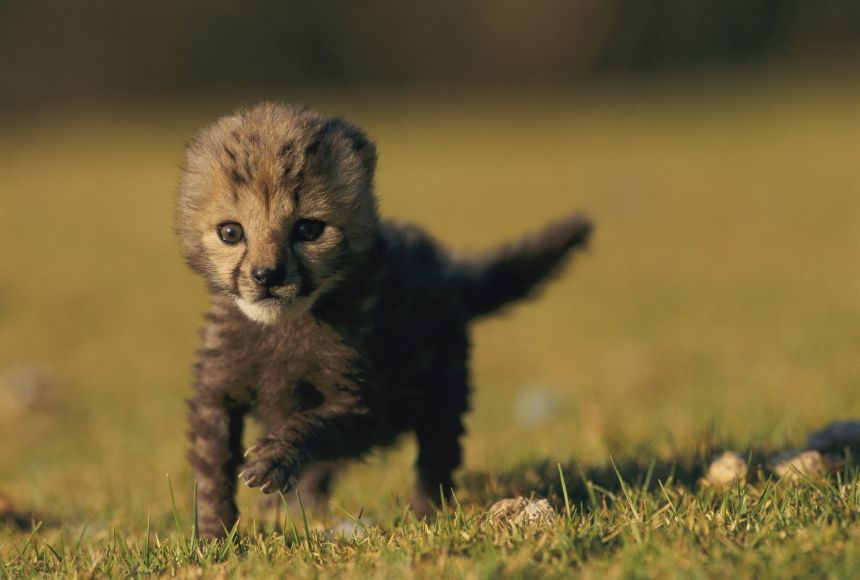Cheetahs (Acinonyx jubatus) are a species of cat best known for being the fastest land animal, with the ability to sprint at speeds of up to 120 kilometers per hour (75 miles per hour) and accelerate to 97 kilometers per hour (60 miles per hour) in as little as three seconds, making them faster than most sports cars. Cheetahs use their acceleration and speed to chase down and catch prey, like gazelles, on the sub-Saharan savannas where many of them live. Cheetahs have small heads, lean bodies, long legs, and a yellowish-tan coat with distinctive black spots.
Cheetahs face extinction pressure from climate change, hunting by humans, and habitat destruction, which is reducing the size of their populations. Cheetahs' own genes also pose a challenge to their continued survival. Cheetahs have a low rate of reproductive success, meaning that as a species they are not always able to reproduce. With fewer offspring, the population can neither grow nor adapt to changes in the environment.
Evolution of Cheetahs
There are various theories concerning cheetah evolution, including a popular one holding that cheetahs descended from the same ancestor as the American puma (Puma concolor). About 10,000 to 12,000 years ago, around the end of the last ice age, an extinction event took place that wiped out many large mammal species around the world, including the wild cheetahs of North America and Europe. The extinction of these early cheetah species left only the Asian and African populations of cheetahs. Since then, they have faced pressure from climate change, habitat loss, and human activities. At the turn of the 19th century, more than 100,000 cheetahs are estimated to have been living in Africa, the Middle East, and elsewhere in Asia. Today, cheetahs are found in the wild in several locations in Africa, and a tiny population of another subspecies, the Asiatic cheetah, is found in Iran. Scientists estimate that fewer than 8,000 African cheetahs are living in the wild today and that there may be fewer than 50 Asian cheetahs left in the world. These data reflect an overall decline of about 50 percent in the last four decades, as well as a significant shrinkage in the historic range of the species.
Bottleneck Events
Cheetahs today are heading toward extinction. Notably, however, cheetahs have faced and overcome the threat of extinction before. Genetic analysis of wild cheetahs shows they may have survived two historical bottlenecks, events that sharply reduce the size of a population. When this happens, the few remaining individuals end up inbreeding, or mating with relatives. Inbreeding reduces the size of the gene pool, which can lead to problems such as decreased genetic variability and the persistence of potentially harmful mutations, making it harder for the remaining population to adapt to changes in their environment. In a very small population, any mutations that occur are much more likely to be passed on to offspring and propagate through successive generations.
The first bottleneck event that cheetahs may have undergone occurred around 100,000 years ago when cheetahs expanded their range into Asia, Europe, and Africa. This range expansion is believed to have occurred rapidly, dispersing the cheetahs over a very large area and thus restricting their ability to exchange genes.
The second likely bottleneck event occurred about 10,000 to 12,000 years ago, around the end of the last ice age. In this bottleneck the cheetahs of North America and Europe went extinct, leaving extant only the species' Asian and African populations. As large mammals died out across the world, the number of surviving cheetahs dwindled, which caused extreme inbreeding. Even though the number of cheetahs grew to as many as 100,000 during the 19th century, their genetic variability remained low due to the extreme bottleneck event that took place thousands of years previously.
Cheetah Genes Today
Present-day cheetah populations have relatively low genetic variability, evidence for which comes from several different indicators. One way to test for the degree of inbreeding is to perform a skin graft. This involves transplanting a piece of skin from one cheetah onto another to see if the receiving cheetah accepts or rejects the graft. In inbred populations, skin grafts are easily accepted by individuals unrelated to the donor. This occurs among cheetahs, suggesting they have lost some genetic diversity. Another sign of inbreeding is asymmetrical skull development. In inbred animals, the skull is more asymmetrically shaped. A study of cheetah skulls in museum collections showed that their skulls are relatively asymmetrical.
A third line of evidence for inbreeding comes from cheetahs’ high homozygosity. Homozygosity is a measure of the genetic similarity between individuals in a population, and the lower a population's homozygosity, the greater its genetic "impoverishment." Cheetah genomes typically exceed 90 percent homozygosity. By contrast, domestic cats (Felis catus) and dogs (canis lupus familiaris), Tasmanian devils (Sarcophilus harrisii), and Virunga gorillas (Gorilla beringei beringei), while all also commonly inbred, have significantly lower rates of homozygosity.
Cheetahs are facing different threats that are collectively pushing them toward extinction. Humans are threatening the species by infringing on their habitat, hunting individuals, and perpetuating climate change. Experts believe cheetahs may also suffer from infectious diseases spread by domestic cats. Cheetahs struggle to cope with these pressures in part because they lack the genetic variability to respond to them effectively. Evidence suggests cheetahs have faced genetic bottlenecks in the past and survived. As the population of wild cheetahs dwindles, only time will tell if it can survive the current genetic bottleneck.
